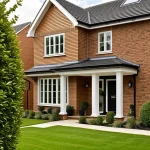Green Real Estate Trends and Market Dynamics in the UK
The green real estate trends UK landscape demonstrates a robust shift towards sustainable property development driven by increasing awareness of environmental impact and governmental support. In recent years, the UK property market has seen a significant uptick in demand for eco-friendly buildings, reflecting both investor interest and consumer preference. This surge is evident in market data showing double-digit growth in the green property sector.
A key factor in this growth is the evolving property market analysis highlighting energy efficiency, reduced carbon footprints, and long-term cost savings as prime motivators. Investors are increasingly drawn to sustainable properties due to their resilience against fluctuating energy costs and regulatory incentives. Additionally, sustainability is becoming a vital selling point for tenants and buyers alike.
In parallel : How do Brexit developments impact the UK property market?
The drivers behind this adoption include stricter environmental regulations, rising energy prices, and corporate responsibility agendas. Property developers incorporate green technologies such as solar panels, advanced insulation, and water-saving fixtures to meet demand. Overall, green real estate trends UK mark a pivotal evolution in the property market, marrying financial viability with eco-conscious development.
Green Real Estate Trends and Market Dynamics in the UK
The green real estate trends UK reveal a significant shift toward sustainable property development, driven by increased environmental awareness and regulatory pressure. Recent property market analysis shows a substantial rise in demand for eco-friendly buildings, with the green property sector experiencing accelerated growth over the last five years.
Have you seen this : How Do Interior Design Trends Impact Well-being in UK Homes?
Key drivers include tightening energy efficiency standards, government incentives, and a growing investor preference for long-term sustainability. Investors are increasingly prioritizing developments that incorporate renewable energy, low carbon footprints, and smart technologies. These elements not only reduce environmental impact but also enhance asset value retention, reflecting broader public and corporate commitments to sustainability.
Statistical data points to an uptrend in green certifications and sustainable property standards, correlating with higher occupancy rates and rental premiums. The market dynamics indicate that properties adhering to sustainable property development principles tend to outperform traditional counterparts in both valuation and tenant appeal.
Understanding these trends is essential for stakeholders seeking a competitive edge. The intersection of regulatory frameworks, evolving consumer preferences, and technological innovation continues to propel the green real estate market forward in the UK, signaling an enduring transformation in property investment strategies.
Investment Benefits and Strategic Advantages of Green Real Estate
Sustainable investment in the UK property market is increasingly recognised for its tangible benefits of green property investment. Compared to traditional real estate, green properties often deliver superior green property ROI due to enhanced energy efficiency and lower operational costs. Investors benefit from long-term asset value retention, as sustainable buildings align with tightening environmental regulations and growing tenant demand for eco-friendly living spaces.
Tenant demand drives a notable premium pricing advantage. Properties with sustainable features attract environmentally conscious tenants who are willing to pay higher rents, reducing vacancy risks. This dynamic reinforces the economic incentives behind sustainable property development. A thorough property market analysis reveals that green real estate investments often incur lower maintenance expenses and offer better resilience against energy price fluctuations.
Moreover, sustainable property development supports future-proofing portfolios against evolving market and policy pressures. With climate change awareness increasing, green properties are positioned favourably in buyer and investor preferences, enhancing liquidity and market appeal. Overall, the combination of regulatory compliance, tenant desirability, and operational savings makes green real estate investment a strategically advantageous choice.
Investment Benefits and Strategic Advantages of Green Real Estate
Green real estate trends UK underscore significant benefits of green property investment compared to traditional real estate. Studies show that sustainable buildings often achieve higher returns on investment (ROI) due to increased tenant demand and operational savings. Tenants are willing to pay premium prices for eco-friendly properties, attracted by lower utility costs and healthier living conditions.
From a financial standpoint, green property ROI benefits include reduced maintenance expenses and resilience against rising energy prices, contributing to long-term asset value retention. Sustainable investment allows property owners to future-proof their portfolios by aligning with evolving regulations and market expectations.
Property market analysis reveals that green developments experience lower vacancy rates, boosting rental income stability. Investors increasingly recognize these advantages as a strategic edge, especially given the growing focus on ESG (Environmental, Social, Governance) criteria.
In summary, sustainable property development not only supports environmental goals but also creates compelling economic incentives. By prioritizing green investments, stakeholders gain a competitive advantage through enhanced profitability, risk mitigation, and tenant appeal—critical factors shaping the UK’s property investment landscape.
Green Real Estate Trends and Market Dynamics in the UK
Green real estate trends UK have shown marked acceleration, reflecting a widespread shift toward sustainable property development. Recent property market analysis highlights that the demand for eco-friendly buildings has surged, driven by heightened environmental awareness and evolving investor priorities. In the past five years, statistical data reveals significant growth in the green property sector, indicating a clear market preference for sustainability.
Investors are increasingly attracted to developments incorporating renewable energy, energy efficiency, and smart building technologies. These elements reduce operational costs and carbon footprints, aligning with tightening regulations and consumer demand. Furthermore, the integration of sustainable property development practices enhances asset resilience amid fluctuating energy prices and regulatory changes.
Key drivers behind this adoption include government incentives, enhanced environmental standards, and corporate responsibility trends. As property market analysis confirms, the green real estate trends UK are not merely a niche movement but represent an enduring market evolution. This shift underscores a fundamental redefinition of value in UK real estate, where sustainability becomes central to investment strategy and property appeal.
Green Real Estate Trends and Market Dynamics in the UK
Green real estate trends UK have shown marked growth, driven by rising demand for sustainable property development and eco-friendly investments. A thorough property market analysis reveals that green buildings account for an increasing share of new developments, with market data indicating double-digit growth rates over recent years. This reflects not only consumer preference but also growing investor confidence in long-term viability and reduced environmental impact.
Key drivers propelling this adoption include government incentives, stricter environmental regulations, and greater awareness of energy efficiency benefits. Investors prioritise developments featuring renewable energy integration, advanced insulation, and smart technologies to meet sustainability targets. Such initiatives align with evolving UK real estate regulations promoting low-carbon standards and reduced waste.
Additionally, the economic appeal of sustainable property development stems from reduced operational costs and improved asset resilience against regulatory changes. Property market analysis highlights that sustainable buildings often yield higher occupancy rates and rental premiums, showcasing strong market dynamics favoring green real estate trends UK. This transformation signifies a shift toward embedding sustainability as a core investment principle, influencing future market trajectories and stakeholder strategies.
Green Real Estate Trends and Market Dynamics in the UK
Green real estate trends UK reflect a pronounced increase in demand for sustainable property development, with a steady rise in eco-friendly investments reshaping the market landscape. Recent property market analysis demonstrates that this growth is not coincidental but driven by deliberate shifts in consumer preferences and investment priorities. Statistical data from the past five years reveal a robust expansion of the green property sector, with market share increases well above traditional property segments.
Key drivers of adoption include stronger environmental regulations, escalating energy costs, and the increasing prominence of corporate social responsibility. Investors recognise that sustainable property development yields benefits beyond environmental impact, such as enhanced energy efficiency, lower operational costs, and improved tenant retention. These factors encourage a move towards renewable energy integration, smart building technologies, and high-efficiency materials.
Moreover, government incentives and stricter building codes bolster confidence in green real estate trends UK. Property market analysis indicates that these forces combine to create a sustainable investment ecosystem, making green properties a compelling choice. The evolving dynamic showcases how sustainability is becoming central to long-term investment strategies, with clear market demand fueled by both regulatory frameworks and consumer awareness.
Green Real Estate Trends and Market Dynamics in the UK
The surge in green real estate trends UK is driven by an expanding demand for sustainable, eco-friendly properties. Recent property market analysis reveals that green buildings now constitute a significant and growing portion of new developments, reflecting investor confidence and changing consumer preferences. Market data indicate consistent double-digit growth rates in the green property sector over recent years, demonstrating sustainability’s rising monetary importance.
Key drivers behind this shift include regulatory pressure, evolving environmental policies, and rising energy costs that emphasize the value of energy-efficient solutions. Investors prioritise developments incorporating renewable energy sources, smart technologies, and advanced insulation—all central to sustainable property development. These elements not only meet regulatory standards but also contribute to future-proofing properties against tightening UK environmental requirements.
Moreover, government incentives and enhanced corporate social responsibility commitments further accelerate adoption. The popularity of greener real estate stems largely from its operational cost savings, reduced carbon footprint, and ability to attract tenants seeking environmentally conscious living spaces. Consequently, sustained property market analysis supports the conclusion that the green real estate sector is poised for continued expansion, reinforcing sustainability as a fundamental market dynamic in the UK.
Green Real Estate Trends and Market Dynamics in the UK
The green real estate trends UK reveal a strong surge in demand for sustainable property development and eco-conscious investments. Recent property market analysis highlights a significant expansion in the green property market, with growth rates substantially outpacing traditional real estate sectors. Between rising consumer awareness and investor interest, eco-friendly buildings now constitute an increasing share of new developments.
Key drivers fueling these trends include tightening UK real estate regulations that promote energy efficiency and carbon reduction, alongside government incentives encouraging sustainability. Investors are motivated by the long-term benefits of reduced operational costs and enhanced asset resilience. These factors contribute directly to increased adoption of sustainable property development practices such as renewable energy integration and smart building technologies.
Statistical data confirms that green properties benefit from higher occupancy and rental premiums, reflecting tenant preference for environmentally responsible living spaces. The combination of regulatory support, market demand, and technological advancement continues to shape the evolving landscape of green real estate trends UK, positioning sustainability as a core component of property investment strategy.





